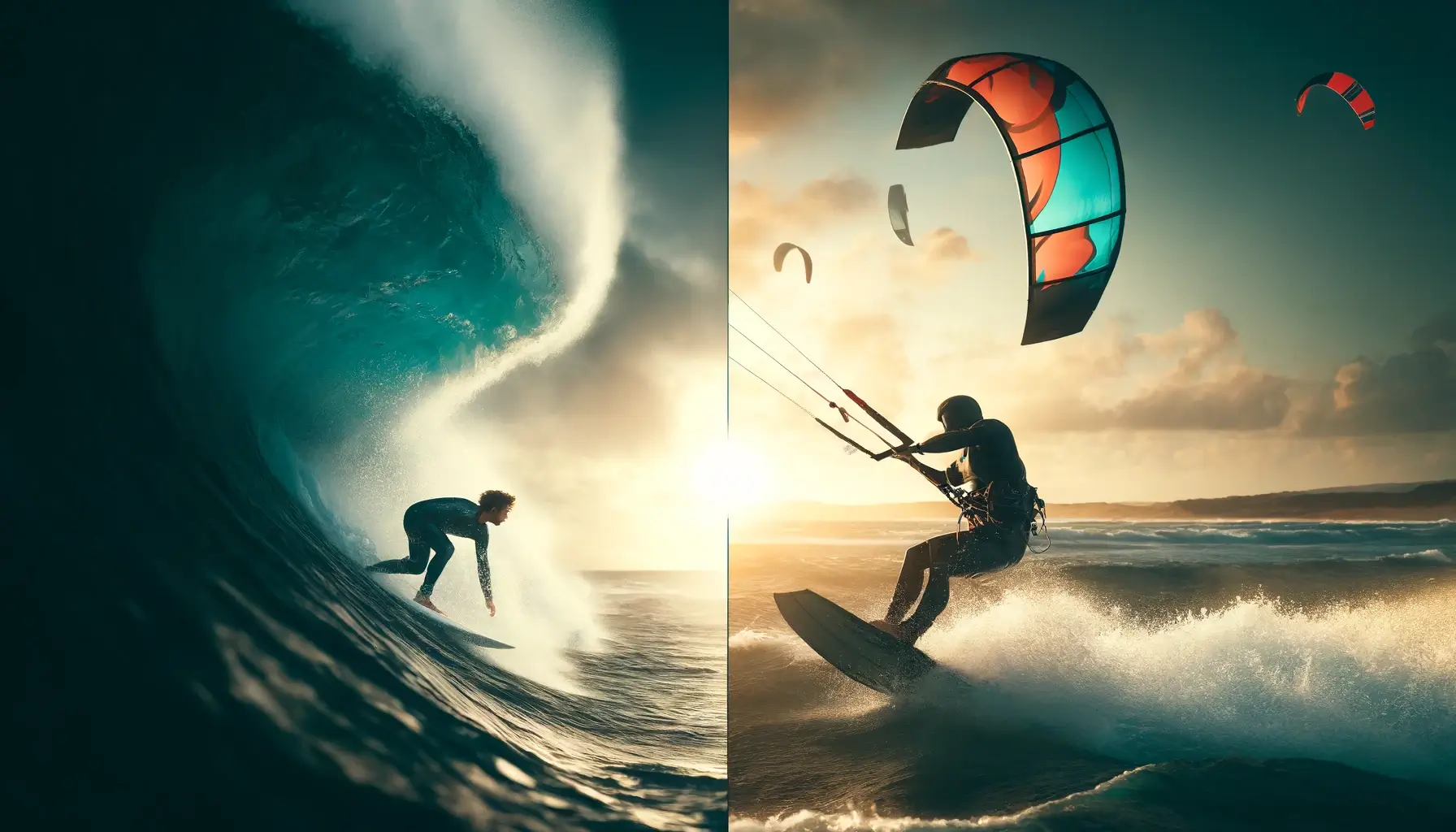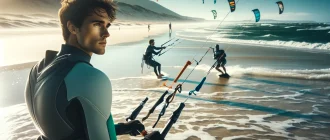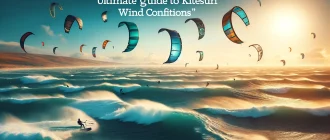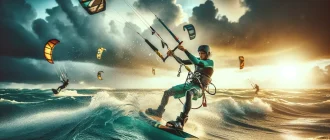Are you torn between the serene challenge of surfing or the exhilarating heights of Kitesurfing? In water sports, these two ride the line between tradition and innovation.
Get straight into the key points that define the two main differences between surfing and Kitesurfing, from the main differences in their reliance on nature’s elements to the differences in the cultural vibes each sport embodies. Kick off your adventure by understanding which sport speaks to your soul—and your sense of thrill.
Key Takeaways
- Surfing is about riding waves and connecting with the ocean, offering a simple and solitary experience, while Kitesurfing combines sailing and flying powered by wind for a dynamic adventure.
- Kitesurfing generally has a quicker and more accessible learning curve with essential wind-handling skills, while surfing requires patience to master catching and riding waves.
- Both sports depend heavily on weather conditions for a safe and satisfying experience, requiring surfers to look for minimal wind and sizable waves and kiters to seek steady, moderate winds.
Here’s a summary table of features and differences between surfing and kitesurfing based on the information gathered:
| Feature | Surfing | Kitesurfing |
|---|---|---|
| Basic Requirement | Waves | Wind |
| Ideal Conditions | No wind or light offshore wind | 12-25 knots, side-shore or side-onshore wind |
| Learning Curve | Longer, requires mastering wave reading and board control | Faster involves learning kite control |
| Equipment Cost | Less expensive, basic surfboard and wetsuit needed | It is more costly due to additional gear like kites and harnesses |
| Safety | Risks include rip currents and collisions with the board or rocks | Risks include kite mishandling and equipment failure |
| Community | Strong, vibrant, and competitive | Growing, with a focus on safety and learning |
| Fitness Benefits | Improves balance, concentration, and cardiovascular health | Enhances core strength, flexibility, and cardiovascular health |
| Practicality | Depending on wave availability, it can be competitive for waves | More flexible with locations, it can be practiced in flat waters, too |
| Equipment Durability and Maintenance | Surfboards are durable with minimal maintenance | Kitesurfing gear requires regular maintenance and is prone to wear |
| Cultural Aspects | Seen as a lifestyle with a deep-rooted culture | Emerging culture, gaining popularity among thrill-seekers |
These distinctions highlight that while both sports are engaging and offer unique challenges and rewards, they cater to different preferences and conditions. Whether one chooses surfing or kitesurfing depends on one’s interests, the environment they have access to, and one’s willingness to engage with the learning curve and community associated with each sport
The Thrill of the Ride: Surfing and Kitesurfing Compared

Imagine the majestic sight of a surfer carving a path on board a towering wave or a top kiteboarding surfer leaping into the sky, propelled by the gusts above. These images capture the big difference between surfing and Kitesurfing – one sport is an ancient dance with the ocean’s rhythms, while the other is a dynamic fusion of sailing and flying.
Many kiters and surfers relish their chosen sport, but proficiency in one doesn’t guarantee an easy transition to the other. Surfing primarily involves wave riding, using the might of formidable waves to sustain the ride.
Conversely, Kitesurfing harnesses the wind and large waves, with the kite serving as the kite surfer’s powerhouse. This allows for diverse conditions and styles of kiteboards and Kitesurfing, from serene kiteboards in flat water to kitesurf in cruising surf to strapless Kitesurfing on towering waves.
The Essence of Surfing
The soul of Kitesurfing, kite surfing, and beach surfing lies in its simplicity and deep connection with nature. Kite surfers learn surfing and beach surfing by:
- Be one with the sea
- Feel its power and nuances
- Seek that perfect wave
- Have an immersive experience
- Be just you, your surfboard, and the limitless horizon.
The joy of surfing comes from its solitary nature, where the only competition is between the surfer and the elements. It is a pure pursuit of personal satisfaction without needing an audience or accolades.
While the sport can be a challenging blend of physical fitness, effort, and patience, the reward is the unparalleled feeling of riding across the surface of large waves, harnessing the ocean’s raw energy.
The Dynamics of Kitesurfing
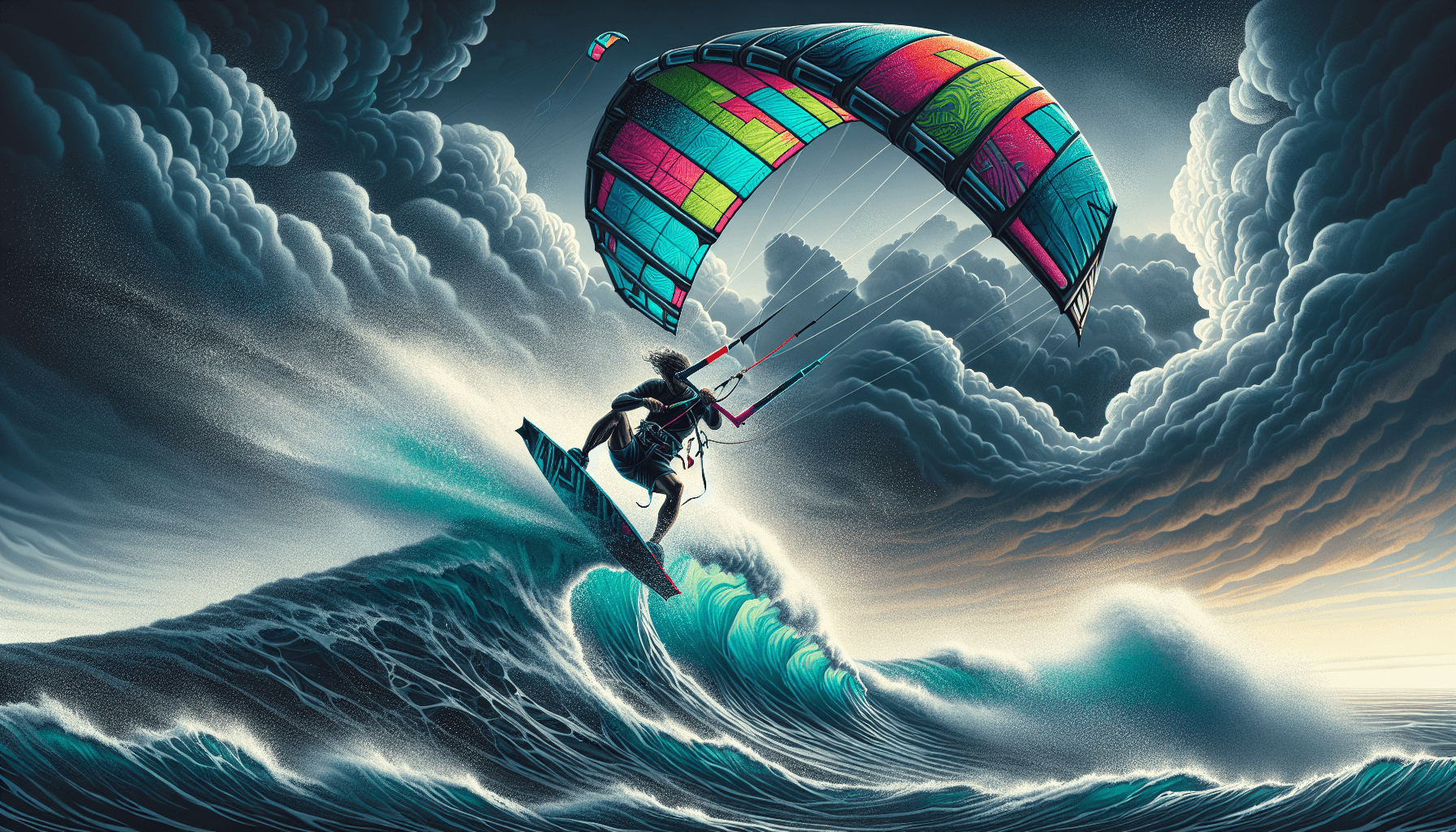
Kitesurfing, known as kiteboarding or surfing, is a thrilling concoction of wind, sound waves, and technological innovation. Unlike the surfer who waits for the perfect wave, the kite surfer crafts their ride through the mastery of wind conditions and kite lines.
It’s a sport that requires a mix of finesse and power, as kiters must understand the wind’s whims and precisely direct the kitesurfers to carve across the flat water or launch strapless kitesurfing them into big air maneuvers.
The kite surfboard is not just a surfboard, board, or sailing board tool but a partner in the dance, lifting the surfer into a realm where surf, board, and sailing board all meet the sky.
Learning Curve: Surf vs Kite
Embarking on the journey to learn Kitesurfing and surfing, or Kitesurfing, surfing, or Kitesurfing brings its challenges and triumphs. The learning curve for these sports is as different as their reliance on the elements.
With its combination of kite flying and board riding, Kitesurfing might seem daunting at first, but it’s generally easier and faster to learn Kitesurfing than its wave-riding cousin. With a few lessons and the right kitesurfing equipment, many kiteboard kiters quickly progress from essential control to confidently riding the wind.
In comparison, surfing requires a greater degree of patience and determination. The early stages of surfing often entail honing reflexes, establishing muscle memory, and comprehending the rhythm of the surf and ocean—a process that can be lengthy and challenging but immensely fun and gratifying once mastered.
Catching Your First Wave
The early phases of learning to surf are packed with the unadulterated thrill of bonding with the open sea, intertwined with inevitable wipeouts while trying to catch your first wave. New surfers often grapple with timing their pop-ups, balancing on the board, and choosing the right moment to ride the wave. A common mistake is poor hand placement, which leads to instability and prevents the surfer from properly riding the wave.
Practice is vital to learning to surf. Start in the forgiving whitewater before tackling small green waves and moving on to more significant challenges. It’s a journey of incremental progress, where each wave caught and boarded on is a triumph, and every fall is a lesson to be savored.
Mastering the Wind for Kitesurfing

In Kitesurfing, the initial stages of the learning process are centered around gaining control over the wind. A kite surfer’s first few lessons are often spent on land, learning to navigate the kite with smooth, controlled movements.
Once comfortable, the student progresses to learning surfing body dragging in the water, gaining a feel for the kite surfer’s power and speed, and learning the crucial skill of water relaunch.
The kitesurfer’s moment of truth comes with the water start—using the kite’s lift to stand on the board. It’s a pivotal milestone in Kitesurfing, the first step to gliding a kitesurf across a flat water fronter’s surface, and a sign that the kitesurfer is well on its way to joining the ranks of those who ride the winds.
Harnessing the Elements: Weather and Wind Conditions
Whether surfing or Kitesurfing, triumph on the water is undeniably tied to the weather’s caprices. Surfers seek the perfect combination of wave size, wind direction, and swell to carve their path on the open sea, while kitesurfers look to the skies for the right wind conditions for their next session.
Understanding these elements is not just about enjoying the sport; it’s also a matter of safety.
The ideal kitesurfing and surfing conditions can vary between the two sports, reflecting their distinct natures. Surfers prefer sound waves with minimal wind to maintain the wave’s structure, while kitesurfers can adapt to a broader range of wind conditions but require enough wind to ride.
Surf’s Up: Ideal Surfing Conditions
For surfers, the dream scenario unfolds with big waves and fun:
- Glassy seas
- A slight offshore wind shapes the waves into perfect barrels for riding
- Wave size and frequency influenced by distant storms
- Knowledge of tides, which can mean the difference between an epic session and a frustrating day at the beach
- Swell direction determines how waves interact with the shore, making certain spots ideal for advanced surfing when the conditions align.
In places like Italy, the quest for sound, good waves, and ideal surfing conditions leads surfers to regions like Sardinia and Tuscany, where sound, good waves, and wind create a surfer’s paradise.
Kite Beach Forecast: When to Hit the Water
For kitesurfers, the wind is the heartbeat of their sport. Ideal conditions are found with steady winds between 15 to 25 knots, coming from the side-shore or side-onshore, which offers the safest and most enjoyable riding experience, especially for beginners.
Kiteboarders and surfers must align their sessions with the wind and tide forecasts to avoid dangerous situations that exceed their skill level and ability.
In the summer, many riders flock to beaches and lakes where thermal winds provide consistent weather conditions, while winter can bring more challenging winds due to atmospheric disturbances.
Gear Up: Equipment Essentials
Regarding equipment, surfing and surfing vs. Kitesurfing occupy contrasting poles of the spectrum. Surfing’s gear requirements are as straightforward as the sport itself, often necessitating nothing more than a surfboard tailored to the surfer’s ability and the waves they’ll face. Wetsuits may also be needed, depending on the water temperature.
Kitesurfing requires a more extensive arsenal of equipment, including:
- Kites
- Lines
- Control bar
- Harness
- Kiteboards
Various types of gear suit different conditions and riding styles, including mountain biking. This means a slightly more significant initial investment and a bit more commitment to learning the intricacies of each piece of gear.
Surfing Simplicity

Part of surfing’s charm lies in the simplicity of its equipment. The iconic symbol of the sport, the surfboard, comes in different varieties, like longboards for leisurely cruising and shortboards for vigorous maneuvers and dangerous out.
The right surfboard can make all the difference here. It allows surfers to glide the board gracefully or carve it aggressively, depending on their preference for it and the surf conditions.
The minimalistic gear requirements mean less hassle, expense, and physical effort, making surfing an accessible sport for those who yearn to ride t big waves heroes.
Kitesurfing Gear Galore

On the flip side, kitesurfing equipment is an ensemble of components, each playing a pivotal role in enhancing the kiter’s experience. Here are some critical elements of kitesurfing equipment:
- Kites come in different shapes and sizes and are designed to perform in various wind conditions.
- Boards: They are chosen based on riding style and experience level.
- Kite lines provide the necessary control and are connected to the control bar.
- Control bar: It steers the kite and controls its power.
- Harness: It provides comfort and support to the rider.
As the kitesurfing industry evolves, so does the equipment, with annual updates to enhance performance and safety.
For those starting to use their kiteboards, the correct kite size for the conditions is paramount, and quality gear from reputable brands can ensure a safer and more enjoyable introduction to the sport.
Community and Culture: The Social Side of Water Sports
The social dimensions of surfing and Kitesurfing are as diverse and vibrant as the sports themselves. Surfing communities are often marked by a strong sense of localism, shaping the dynamics at popular spots and influencing the camaraderie among riders.
This sense of belonging can be both welcoming and competitive, but it is always rooted in a shared love for each other things the surf.
On the other hand, Kitesurfing is known for its inclusive and supportive culture. Initiatives to make the sport more accessible have helped foster a community open and eager to welcome newcomers, creating a friendly atmosphere often praised by those new to the sport.
Surfing’s Competitive Edge
Competitive surfing has taken the sport from the beaches to the world stage, where professional surfers vie for titles and glory. This competitive edge has sparked debates among surf itself about how competition shapes surfing culture and whether it detracts from the sport’s traditional values.
While some argue that it limits creativity, there’s no denying the dedication required to compete at the highest levels in one sport. The competitive scene can be as thrilling as the waves, with each heat showcasing athletes’ adaptability, physical fitness, and mastery of the waves.
Kitesurfing’s Friendly Skies
The kitesurfing community, meanwhile, often feels more like a family than a competitive arena. Although a relatively new sport, Kitesurfing has fostered a culture of inclusivity and support. Initiatives that seek to make kitesurfing accessible to a broader audience contribute to a welcoming environment that encourages participation and growth.
Whether you decide to launch into big air or learn to control your kite, you’ll find plenty of encouragement and advice from fellow kiters, making the learning process as fun as it is challenging.
Adventure Level: Safety and Risk in Water Sports

Surfing and Kitesurfing provide exhilarating experiences, yet each has unique risks and safety factors to consider. Seasonality, weather fronts, and other factors can significantly impact surfers’ safety, with winter bringing hazardous conditions like stronger winds and more giant waves.
Kitesurfing, recognized as an extreme sport, demands careful attention to safety precautions and equipment maintenance. Whether you’re a seasoned kite pro or a beginner, understanding these risks and how to mitigate them is crucial for an enjoyable and safe time on the water.
Surfing’s Hidden Hazards
Surfing’s laid-back image belies the presence of hidden hazards that every surfer must know. Some of these hazards include:
- Rip currents, the silent threat of the surf zone, can quickly sweep the unwary out to sea.
- Unpredictable seabed terrain can add layers of risk to an otherwise idyllic pursuit.
- The presence of marine life can also pose a danger to surfers.
- The equipment that allows surfers to ride the waves – their boards with pointed tips and sharp fins – can become dangerous in a wipeout, leading to severe injuries or even collisions with other surfers in crowded spots.
Surfers must know these hazards and take necessary precautions to ensure their safety.
Despite these dangers, the surfing mountain biking community continues to thrive, with respect for the ocean and a commitment to safety.
Kitesurfing’s Extreme Sport Status
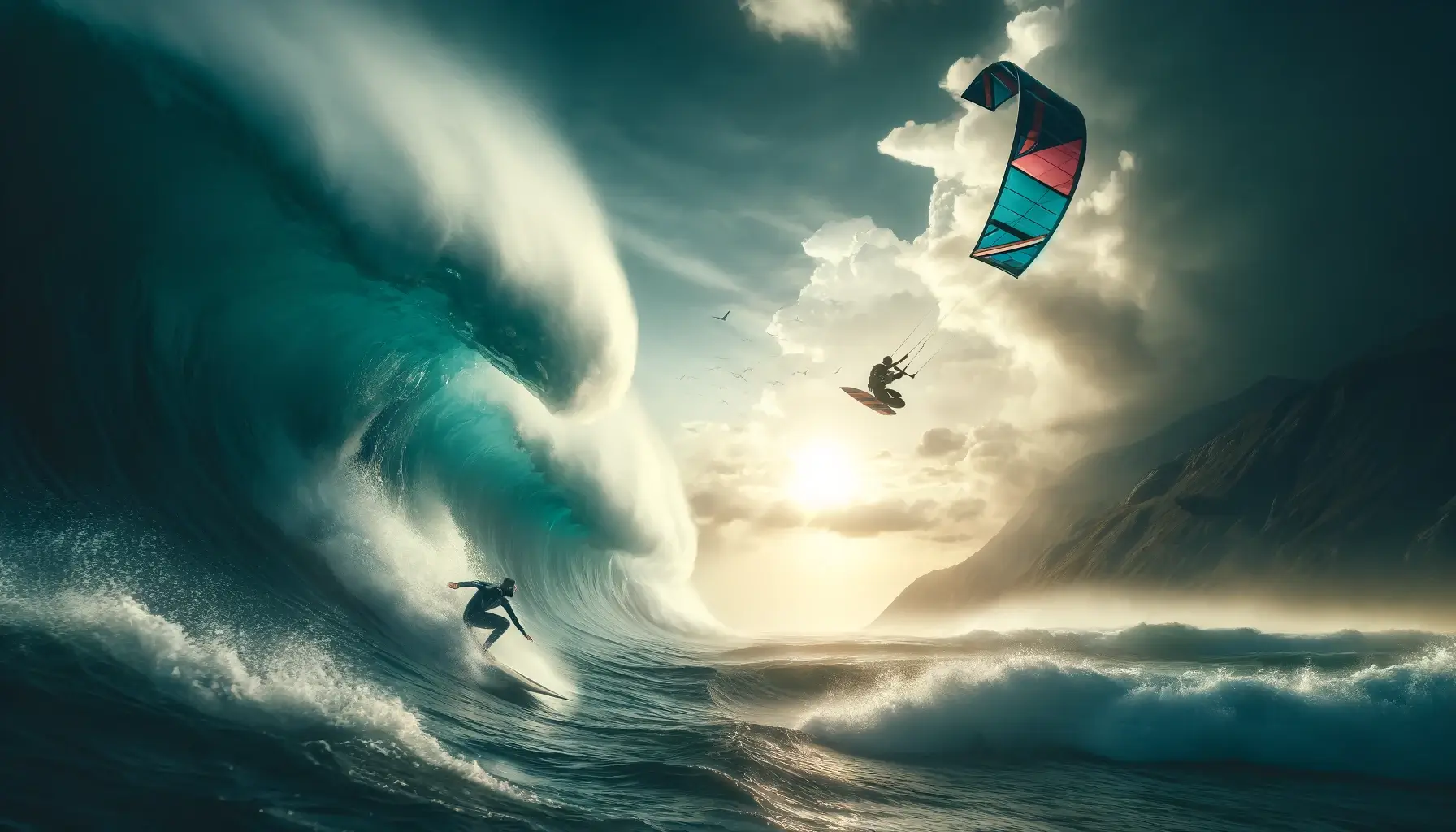
Kitesurfing’s classification as an extreme and dangerous sport is not without reason. The very nature of being pulled across the water at speed and launched into the air by the wind carries inherent risks. That’s why a kitesurfer’s checklist always includes:
- Thorough equipment checks, particularly of the kite lines and safety systems, before every session
- Safety gear such as helmets and impact vests, which are not just accessories but essential parts of a kitesurfer’s kit
- Self-rescue techniques and the practice of kitesurfing with a buddy system are strongly advised
These preventative measures and a healthy respect for the wind and sea conditions help ensure that kitesurfers can enjoy their sport while mitigating the risks.
Overview
As we ride the crest of this wave to the shore, it’s clear that both surfing and Kitesurfing captivate us with their unique blend of thrills, skills, and connection with the natural world.
Whether you’re drawn to surfing’s meditative rhythm or Kitesurfing’s exhilarating dynamism, each sport offers a profound way to engage with the elements.
With the right approach to learning, respect for the conditions, and a solid understanding of the necessary equipment and safety measures, you can carve out your own path on the water. So, are you ready to set sail and chase the horizon, propelled by waves or wind?
Frequently Asked Questions
What is easier surfing or Kite surfing?
Most people find kitesurfing easier to learn than surfing, but both sports require time and practice. So, if you’re looking for a quicker learning curve to learn surfing, Kitesurfing might be the way to go!
What’s more challenging, kitesurfing or windsurfing?
Windsurfing is generally considered easier to learn than Kitesurfing or sailing, requiring only a few hours of instruction to start sailing independently. So, if you decide to sail and are looking for a quicker learning curve, windsurfing may be the better option.
Is kite surfing hard on the body?
Yes, kiteboarding and surfing can be hard on the body, especially the back, due to the strain from movements and landings on kiteboards. It’s essential on kiteboards to be aware of the potential impact of kiteboarding boards on your body and take precautions on kite beach boards to avoid injury.
What are the disadvantages of Kitesurfing?
The main difference and disadvantage of Kitesurfing surfing is its heavy reliance on specific weather conditions, particularly having enough wind to make kites to practice the sport. Additionally, adapting to changes adaptations for safe Kitesurfing would be best.
What are the ideal weather conditions for surfing?
Ideal surfing conditions include sound waves with minimal wind or a light offshore breeze, swell direction, and tide levels, which play a significant role in the surf. So, when heading out to the beach, look for well-structured, rideable waves, keeping these factors and others in mind.

